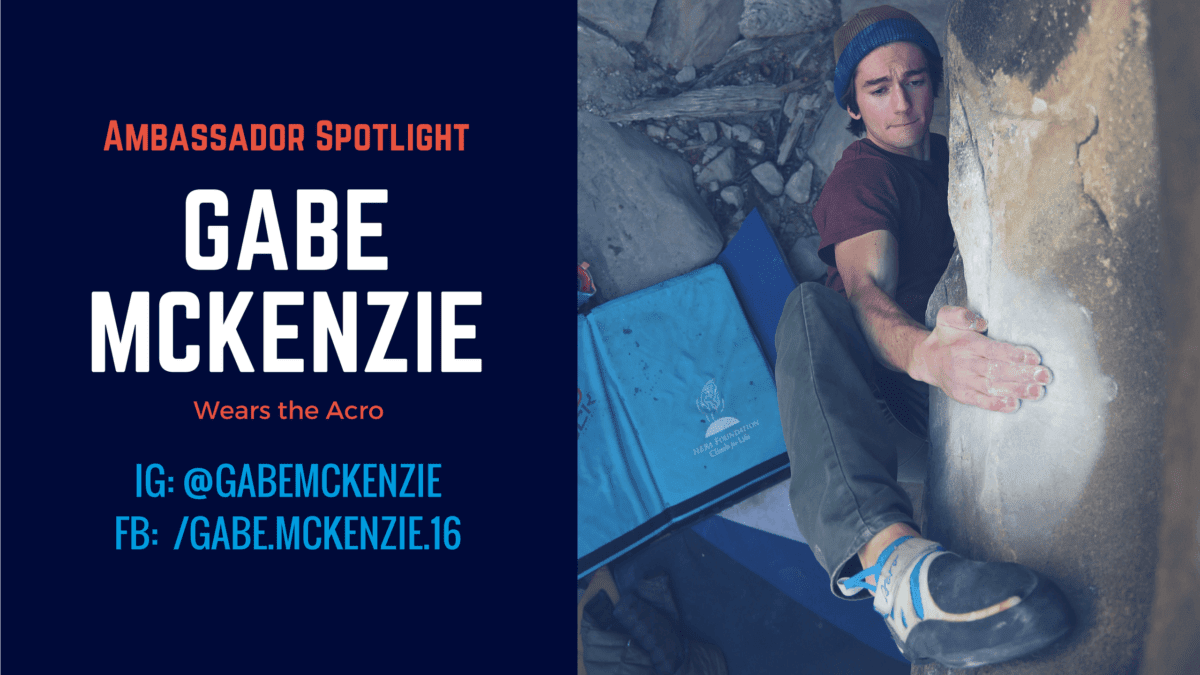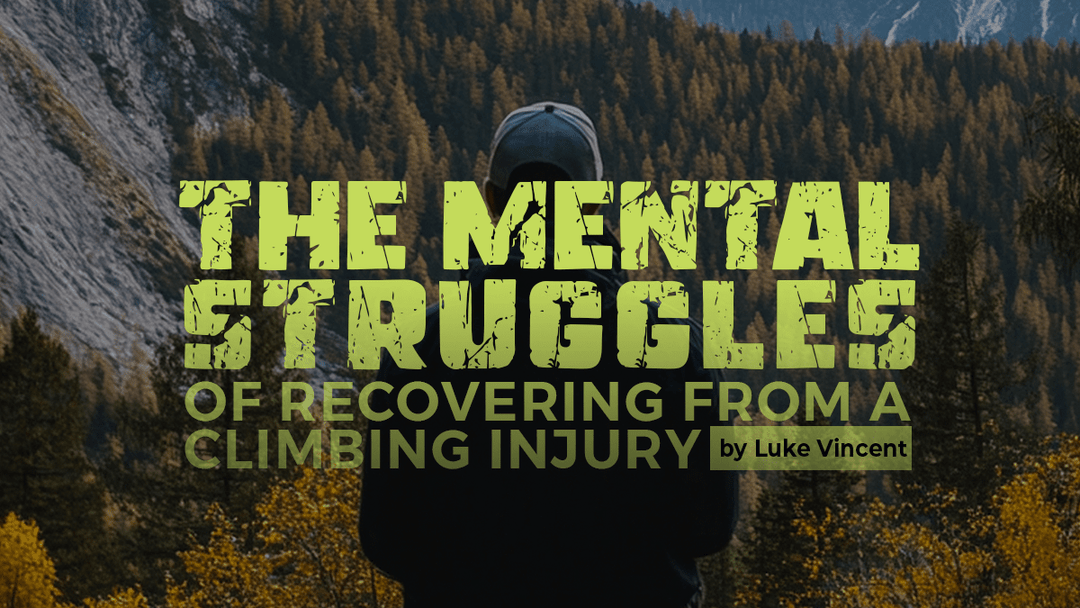Ambassador Spotlight | Gabe McKenzie

Hometown: Baltimore, MD
Q: What’s your climbing style?
A: Bouldering
Q: Who do you take advice from and why?
A: A lot of the best advice I’ve received has come during the long drives back from climbing trips or late night hiking adventures surrounded by just a few people. Almost always everyone is completely thrashed, hungry, and ready for a warm bed. Something about this combination of feelings creates a closeness and facilitates some pretty interesting conversations. I actively try to remain open to all the advice and lessons I take away from these intimate interactions. Through considering these little bits of wisdom I can find something of value. But if I had to choose a single person, it would be my dad. His advice is thoughtful and comes from a life of adventuring and the impressions these adventures have left on him.
Q: How has your training for climbing changed in the last year?
A: I have only recently started designing different training programs with the help of C4mp Human Performance that change every six weeks or so. Weighted pull-ups are my favorite exercise. You can’t ever have too much pulling power when it comes to bouldering. I have also refined my training; it is more strategic and thoughtful. I listen to my body and don’t push myself to the point of injury (if you’re injured, you can’t really train). In the past, I have had a lot of shoulder and back injuries, so I have begun to place a heavier emphasis on prehab and incorporating workouts that create an overall strong and healthy body. This is not necessarily always climbing specific. Nutrition is a big part of my training as well. I don’t have a particular diet, but I know what foods make me climb and feel worse, so I avoid those. I also know what foods fuel me the most before a long day climbing outside or training, so I try to incorporate them into my diet as much as I can before a session.

Q: What have you done to give back to the climbing community?
A: Climbing has given so much to me that I am passionate about introducing it to others. While in high school, I helped establish a climbing team that grew from six people to nearly half of the small school. I also served as bouldering coach for the team and helped students one on one. To give back to the sport, I have been a strong ambassador and advocate. During college, I have led outdoor climbing trips through the Warren Wilson Outdoor Program, which included teaching students to “leave no trace.” I highlight the importance of environmental protection for keeping our boulders and cliffs accessible and beautiful.
Q: What have you learned from failure?
A: Well, what I have learned from failure at this point in my climbing is this: Failure can, in a sense, pave the way to success, both in life and in climbing. Every failure can teach you something if looked at with the right perspective. Failure, as I see it, builds upon your level of experience, which can lead to deeper insight and better judgment. As one example, without failing for so many sessions on “Radiant,” one of my long projects a couple of years back, I wouldn’t have taken away with me certain tools (calming my nerves and the power of staying positive). Both tools I now use in life outside of the climbing world.

Q: Who are the climbers that inspire you the most and why?
A: If I had to choose a single climber who inspires me it would be Yvon Chounard. Not only for his personal climbing experiences and accomplishments but also the role he has played as an ambassador for the sport and for his dedication to bringing awareness to environmental issues. In addition, climbers that keep the psych high no matter their performance that day are also the climbers that inspire me. They lighten the mood and provide a constant reminder as to why I started climbing in the first place. Through my trips with these individuals, I notice my climbing performance increase. I don’t get in my head quite as much when with these inspiring climbers.
Q: What is your favorite climbing location and why?
A: Joe’s Valley, Utah, would be my favorite climbing location. The style of climbing fits me pretty well. I grew up climbing in the gym and competing, so when I was first introduced to outdoor climbing there was a big learning curve for me. Climbing inside and climbing outside is really two different sports. Joe’s Valley boulders feel the closest to gym climbing for me. The location is also pretty great, there is easy camping, a lot of the hikes aren’t too heinous.

Q: Why Butora Climbing?
A: The way the shoe fits me, the performance of the shoe, and the philosophy of the company are three of the biggest aspects that brought me to Butora. Finding a shoe that fit my heel so well has been a constant problem for about seven years before finding Butora. I have tried all of the brands and the Acro Narrow fits better than anything else I have tried. That along with knowing a couple of the team members and having seen how close the Butora community drew me in. I am psyched to be a member of the team. This team is something I wanted to be a part of for a long time!
Q: What are your favorite before and after climbing meals?
A: My favorite before climbing meal would be half a Chipotle burrito bowl. My favorite after climbing meal would be the second half.

Q: What is your spirit animal?
A: A sloth.
Questions from the Internet
Q: What are some tips you would give to new outdoor climbers about crag etiquette?
A: Be sure you are ready to go outside before going. For example, if bouldering, make sure you have a strong understanding of how to safely spot, because generally spotting is much more important outside. If rope climbing make sure you are confident in your knots before going outside. Be respectful of other climbers. For example, don’t play music if there are other climbers around unless you ask. “Leave No Trace.” Clean up after yourselves, make sure not to leave trash of any kind, and even if you see trash that isn’t yours, pick it up anyway. Wipe away tick-marks and unnecessary chalk marks. It is important to remember that a lot of times climbers are not the only ones who enjoy the crag. Hikers and various others come around to be outside and keeping the rock as close to how you found it is important.

Q: Tips you would give to someone who is stuck on their project? How do you stay motivated when you are stuck?
A: Sometimes the best thing to do is to take a break from your project, focus on other climbs you have wanted to try. Allow some time off of the project if you aren’t making progress. For me, this is helpful because a project can get so in your head and many times it becomes more of a mental battle than a physical one. So taking time off and coming back with a clear mind may go a long way.
Q: How have you overcome fear in climbing (fear of falling, fear of failure, etc.)?
A: It is good to have some level of fear because that is what many times keeps you safe and in check with your own capability. But there is a strength that comes with conquering the smaller fears. For example, pushing past the fear of falling when you really know your spotters and gear have you is a positive fear to overcome because that is more a perceived fear than an actual one. Compare that to bailing on a boulder when the top-out is chossy and unpredictable. In this scenario, it may be smarter to listen to that fear and bail from the boulder. To state simply, it is more important to understand what type of fear you are facing and embrace it rather than simply overcoming fear altogether.




